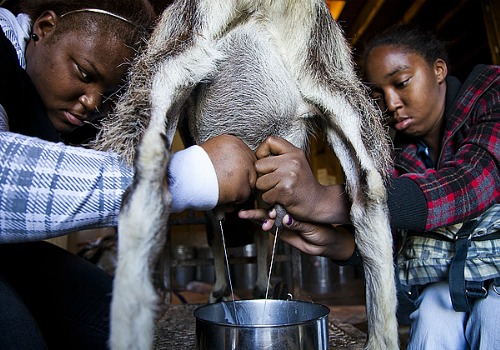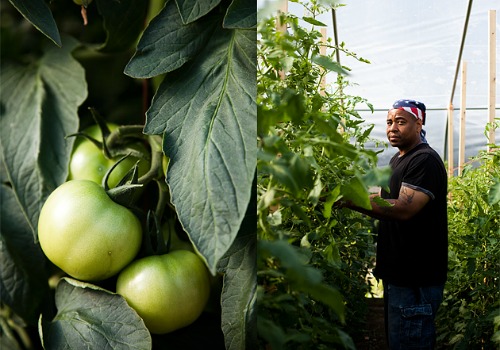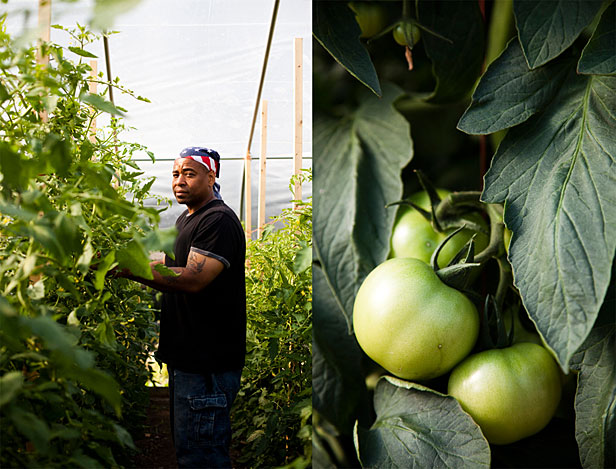 In 2010, Grist ran a series of posts chronicling a road trip across American by a team of young men looking to document our nation’s urban farms for a book called Breaking Through Concrete (you can see a list of the posts over on the right of the page). Sponsored in part by WHYHunger, David Hanson (writer), Michael Hanson (photographer), Charles Hoxie (videographer), and Edwin Marty (farmer and writer) drove across the country in a biodiesel-fueled, internet-enabled short bus.
In 2010, Grist ran a series of posts chronicling a road trip across American by a team of young men looking to document our nation’s urban farms for a book called Breaking Through Concrete (you can see a list of the posts over on the right of the page). Sponsored in part by WHYHunger, David Hanson (writer), Michael Hanson (photographer), Charles Hoxie (videographer), and Edwin Marty (farmer and writer) drove across the country in a biodiesel-fueled, internet-enabled short bus.
This month, the book, Breaking Through Concrete: Building an Urban Farm Revival, finally hits the shelves. To mark the occasion, we caught up with David Hanson to get the lowdown on the book and hear his observations about this moment in urban farming.
Q. Which came first: the book deal or the road trip across the country to document urban farms?
A. We wrote a book proposal and got a deal with University of California Press. We had the idea long before then, but the deal was what sent us on the road trip.
We wanted to make a book celebrating urban farms — and not some sort of doomsday, “we’re all going to die because we’re eating bad food” kind of thing. There’s some truth to that, but we wanted to make it a real celebration and kind of glorify those great projects that are addressing the problems [in our food system].
We also wanted to debunk the myth of the urban farm as either a random vacant lot run by one or two people or some yuppie hobby garden. We wanted to show that there’s a wide variety of urban farms meeting a lot of needs in their communities beyond just growing food.
Q. Can you say more about what kinds of needs are they meeting?
A. Well, there are projects like the Homeless Garden Project in Santa Cruz, Calif. — they employ and train homeless people for a three-year term. They bring them off the street and have them work on the farm, where they gain life skills and job training while growing really high-end organic produce that’s sold throughout Santa Cruz.
There are also a couple of interesting projects that involve refugee groups. Denver, Kansas City, and New Orleans all have areas that have been populated by Bhutanese, Sudanese, and Somalian refugees, and in New Orleans there’s a big Vietnamese population. Those folks come over and stay in these clusters. They end up working in airports and hotels, and obviously it’s a difficult transition, especially for the women. There’s not a lot of work opportunities, so growing food is a means of supplementing their diet and income, and [having] a gathering place where they can feel like they’re at home. So that’s been really cool to see urban farms meet that need for refugee populations.
New Roots for Refugees is a program that’s getting immigrant women into small-scale growing and selling in the markets around Kansas City.
Then there’s Growing Home in Chicago, which is working with recently incarcerated people. They work just for the growing season. They’re working in the farm in the morning harvesting, growing, etc., and then in the afternoon, they have a more formal classroom setting, where they’re learning job skills, resume skills, etc.
Then there’s Jones Valley Urban Farm in Birmingham. They have a really powerful education mission, in addition to being a working production farm. So they coordinate with the local YMCA, and with high school and college interns who work on the farm each year.
They’re like social service programs that grow food.
Q. What surprised you most when you were on this tour?
A. The diversity. The fact that the farms we saw were all doing something a little different. They’re all still operating in an experimental mode because there’s so little precedent for this kind of project. So seeing how each of these projects are adapting to what’s going to make it work financially and what works in their community.
There is no universal rule book for running an urban farm, and it requires a high level of flexibility and a real nimble maneuvering through what’s going on in your immediate surroundings.
Q. How do you think urban farming will move through this current trendy phase to get integrated into more people’s daily lives?
A. That’s a huge question. Today’s youth are seeing a lot more “green” messages — from recycling to hybrid cars, and food fits into that. We can be cynical as adults because we see adults not changing their behavior, but the encouraging part is that the kids are seeing this stuff and it’s ingrained in them from the beginning.
Most urban farms recognize they’re not going to feed the masses, but they have access to hundreds of people and can raise their awareness. Taking kids onto the farm and showing them where a carrot comes from is really powerful.
I also think that key to moving beyond the trend is building an industry in food.
Katherine Kelley, the director Cultivate Kansas City, speaks really eloquently about this. She says that urban farms can’t all just be nonprofits. They can’t just be these cool little projects we see on the corner that make us feel good about ourselves. They need to produce really good food that people want to buy and hit that triple bottom line.
The industry of food is a large spectrum, from someone having chickens in their backyard and selling eggs, or growing tomatoes and selling those, to a small city farm, to moving that kind of square footage-type growing into more para-urban and rural areas where you can grow in acres, and then taking those biodiverse, intensive farming methods that are being practiced and experimented within the city and moving that to farmland.
Q. There are also a lot of people envisioning corporate urban farms, Hantz Farms in Detroit being one of the best examples (although it sounds like that hasn’t come together yet). Many of the vertical farms being proposed in cities are not community-based at all, but seem to tip into agribusiness in a more traditional sense.
A. That’s a huge argument. I think that’s the natural progression with anything — it’s going to get co-opted and become too big. Some people would say, “Bring it on! We need good healthy food, so if corporations can do that on a larger scale, great.”
On the other side of the argument — some folks in Detroit argue that if Hantz comes in, it will be like the Walmart of urban farming, and will annihilate the small producers who are dependent on restaurants to buy the high-end produce so they can run these socially beneficial programs.
So, who knows? It’s all such a Wild West-like frontier right now.
Q. Do you want to talk about any of the challenges these farms are facing?
A. The core challenge is staying afloat financially and — as you’ve asked — how to outlast these trends.
With a lot of the social missions in a lot of these farms — like with the Homeless Garden project — there’s the added challenge of growing really high-end food, and that can sometimes contradict these goals of providing a safe learning environment for these homeless people who aren’t trained in horticulture. So there’s that dilemma: How do we support these folks and grow really good produce?
And then there are the typical thefts and petty things around the farm. You know, a tractor stolen can really crush a farm for a year financially. And a lot of them are in low-income areas where there’s a lot of need, so there’s that issue. The answer is often getting the neighbors invested in it like it’s part of their community.
Q. What’s next for the Breaking Through Concrete crew?
A. The book’s been out for less than a month, so we’re putting together a jerry-rigged book tour and giving some readings and presentations around the topic of people connecting with food.
Check out this slideshow of photos from the tour, and stay up to date on the tour here.




